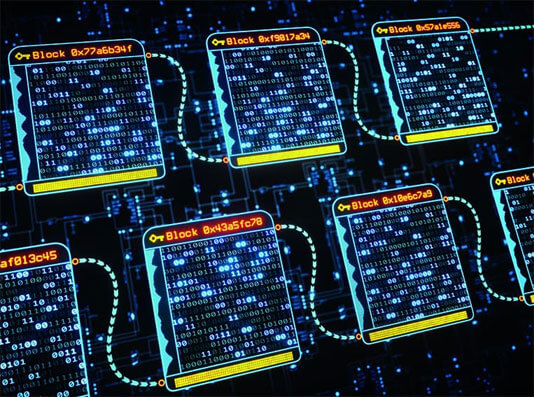What is the blockchain, how it works, validation protocols, types
– Learn these tips and tricks on how to use your devices in a much easier way as well as solved some of your common problems that are difficult.
The world of cryptocurrencies fascinates more and more people every year, from entrepreneurs to simple students. It is not easy to explain such a complex subject in simple words, now that the public is no longer a narrow niche, but the mass. Someone, however, will have to do it. In today’s article we will talk about blockchain, a subject on which there is still a lot of confusion.
First we will explain things the blockchain, in order to immediately have a general picture. Later we will deepen the theme by adding other elements, in order to create a simple and at the same time complete guide.
What is the blockchain?
Let’s start with the basics: the literal meaning of blockchain is a chain of blocks, according to the English to Italian translation of words chain (chain) e block (blocks). However, this definition is of no use to those who want to understand what blockchain really is.
So let’s try to explain it better. Imagine the blockchain as a large shared ledger, the information of which is accessible to anyone, where each block corresponds to a new transaction.
The blockchain is regulated by three basic principles:
- it is not editable;
- it is safe;
- it has no central authority.
In summary, the blockchain is a shared, immutable registry of encrypted data, which is based on a decentralized system.
Read also: NFT, what non-fungible tokens are and how they work
What is the difference between blockchain and Bitcoin?
One of the reasons that generates more confusion on the subject is the frequent overlap between blockchain and Bitcoin. To simplify, there are those who think that blockchain and Bitcoin are the same thing, but in reality this is not the case at all.
In fact, it would be a bit like saying that Windows and Paint are the same, or that Android and Google Chrome are superimposable.
To explain in simple words the difference between the blockchain and Bitcoin, imagine the blockchain as an operating system and Bitcoin as an application. Easy, right?
The blockchain is nothing more than an encrypted register in which the transactions of a cryptocurrency such as bitcoin are recorded (for example) (a large variety of other data can also be noted). Transactions are the movements of bitcoins, from one digital wallet (wallet) to another. In the next few paragraphs, we will be even more detailed in this explanation, introducing the term smart contract.
Who invented the blockchain?
If today many people confuse blockchain and Bitcoin, the “fault” is also of Satoshi Nakamoto, which in the 2008 invented the blockchain to record future Bitcoin transactions.
At the beginning, therefore, there was a strong link between the blockchain and the most famous cryptocurrency in the world today. But now that more than 10 years have passed, things have changed: the blockchain has evolved, it is no longer just a system used for cryptocurrency transactions.
For example, it certifies the origin of a food product, secures copyright, and is the reference point for those who want to register a new patent.
How? The time has come to talk about smart contracts.
What are smart contracts?
Literally, the word smart contract can be translated into “smart contracts”. To be more precise, smart contracts are gods IT protocols that make the verification and compliance with the clauses of a contract automatic.
Very well, but what does the blockchain have to do with it?
The blockchain is the ideal system on which smart contracts are based: thanks to it, users who enter into a contract and define the if / then clauses through smart contracts are guaranteed that:
- all operations are managed independently and automatically by the blockchain
- your information is safe thanks to encryption
- the data is accurate, there is no risk of errors or poor accuracy
- the clauses cannot be modified by the parties
- contractual obligations are transparent
You might also be interested in: How to buy Bitcoin and other cryptocurrencies
How the blockchain works
To understand how the blockchain works let’s take cryptocurrency transfer as an example, one of the most frequent operations in this field. The transaction is based on double key encryption, one private and one public. There private key allows the two users to make available the amount of cryptocurrency previously established for the exchange, instead the public key it hides the content of the transaction to proceed with the validation and subsequent addition of the blocks through one of the protocols provided.
Closing the transaction presupposes his insertion into a block. One of the two parties presents the transaction to the blockchain, paying one commission to the so-called validators, the figures who carry out the computational work during the proof of work. Typically the transaction with a higher commission takes precedence over the others, i.e. it is stored first in the blockchain.
Each block, therefore, includes the list of validated transactions and a hash identification based on the proof of work essential for validation. Specifically, the hash is transcribed in the header of the block that follows immediately after. Since each hash depends on the content of a block, any attempt to modify it would make it impossible to verify the hash and consequently would skip both the block of the reference transaction and the other subsequent blocks.
Validation protocols
As mentioned above, the insertion of a block in the blockchain requires a validation process, or rather a “distributed consent“. The network consent mechanism also determines how the network updates and changes the information in the registry.
In this regard we speak of consensus algorithms o validation protocols: the most common are Proof of Work (PoW) and Proof of Stake (PoS). They play a crucial role within the blockchain, since guarantee the security and integrity of the information present on the registers.
Proof of Work, which can be translated into proof of work, is based on solving complex mathematical problems. The PoW is closely linked with the mining: the so-called miners must solve the mathematical problem in order to find the connection hash between one block and another (the solution) and receive a reward in exchange (a Bitcoin or another cryptocurrency). The subsequent validation of the block requires the consent of the other nodes in the network, which repeat the operation resolved by the miner to verify its accuracy.
Important: Only the first miner who can find the solution is eligible for the reward.
The Proof of Stake was born as an alternative to the Proof of Work to find a solution to the problems related to the huge demand for energy and electricity of the first consensus algorithm. In the PoS the mining process is replaced by the commitment by the so-called validators of a share of their cryptocurrencies. The procedure for selecting the validators takes into account factors such as the amount of the cryptocurrency share deposited and the longevity of the deposit itself.
Note: the Proof of Stake consensus algorithm, unlike the PoW, provides as a reward a fee withheld on the validated transaction.
Fork
We previously wrote that the blockchain is immutable: true, but this does not mean that the protocol or its documentation cannot be updated. This operation is called fork and must be accepted by all users participating in the blockchain.
The primary goal of a fork is improve the speed of transitions, through the implementation of a new code.
Within the blockchain, there are two types of forks:
With hard fork we mean a net split from the original blockchain, therefore the creation of a new source code that does not provide for the exchange of data between the two networks.
Instead soft work refers to a milder split, after which backward compatibility with the previously used blockchain is maintained.
On the same topic: GRAM, Telegram’s new cryptocurrency?
Types
The blockchain can be built in various ways, which is why there are various types:
- Public blockchain: anyone can access and participate. It was the first form of blockchain to see the light in 2008, when Satoshi Nakamoto invented the blockchain to record transactions with the Bitcoin cryptocurrency.
- Private blockchain: unlike what happens in the public one, it is controlled by a single organization that determines who can carry out transactions and participate in their validation.
- Consortium blockchain: a pre-established group of companies or entrepreneurs decides the access and participation criteria.
Wanting to go into more detail, the public blockchain (or permissionless) refers to the first era, when it was only used in the cryptocurrency sector. Year after year, the blockchain spreads to other environments, which have the characteristic of being semi-closed or closed.
Hence the need to introduce a new type that takes the name of blockchain permissioned. To conclude, private blockchains are often the result of the creation of consortia for certain market sectors.
You might also be interested in: Best exchanges to buy cryptocurrencies

















